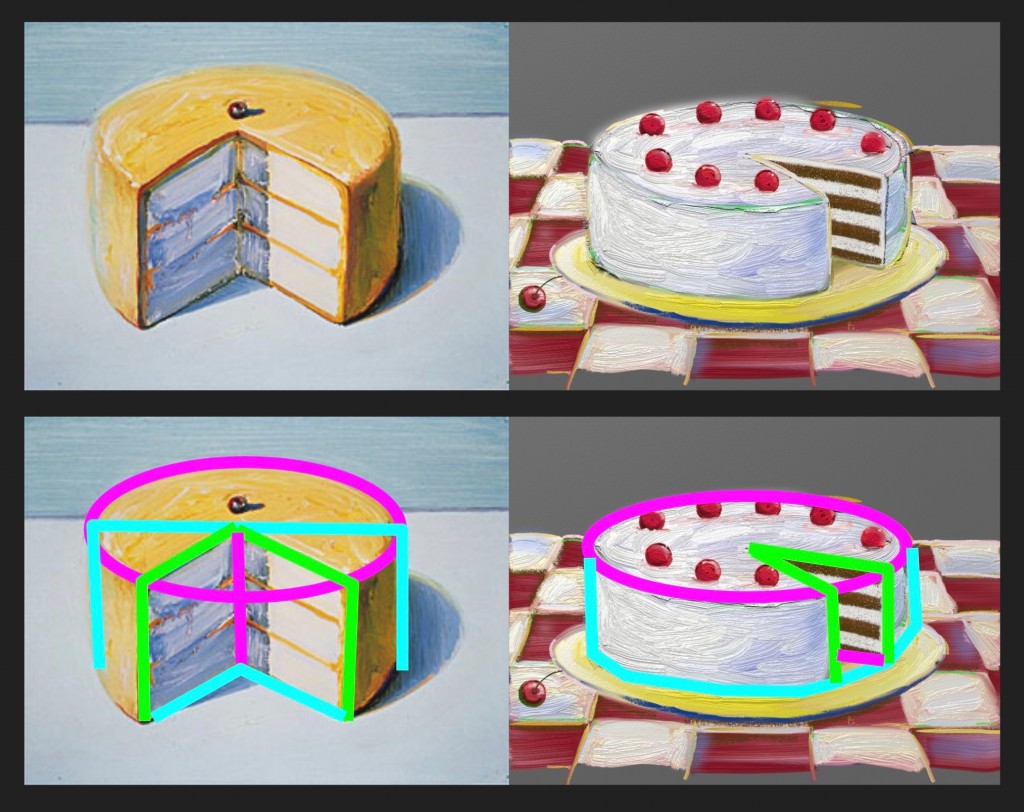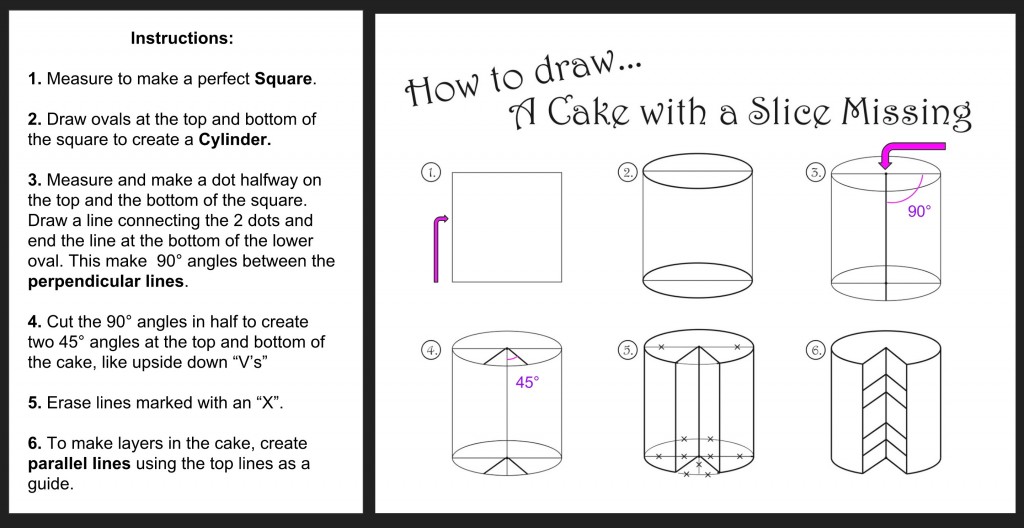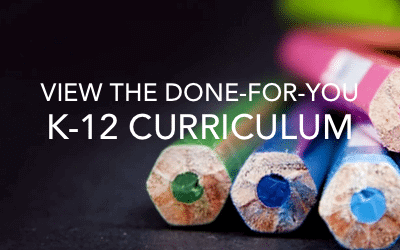Wayne Thiebaud is an artist made famous by his paintings of desserts. His artwork looks good enough to eat. The thick application of oil paint has the texture of real frosting, meringue, and fillings with delightful values and colors.
Though Thiebaud’s paintings look complex, artists of all ages can create cakes of their own. Once we break it down, step back, and realize that all artwork is composed of basic shapes and lines, we begin to see the geometry at play.
When we specifically dissect the form of a cake, we are talking about cylinders. We need to use angles to create missing slices. Along with 3 Dimensional shapes and angles, we must also use perpendicular and parallel lines in order for our drawing to be in perspective. Wayne Thiebaud inspired cake drawings are a perfect pathway for Arts Integration by using Math and Visual Arts concepts.
Math Concepts:
- Angles (45° and 90°)
- 3 Dimensional Shapes/Forms
- Perpendicular Lines
- Parallel Lines
- Measuring
- Using Mathematical Tools
Art Concepts:
- Color Families/Theory
- Texture
- Observing Artistic Works
- Form
- Shape
- Line
- Value
- Space/Perspective
Materials:
- Drawing paper for Sketching
- Pencils/Erasers
- Rulers/Protractors
- Oil Pastels
- Paper Towels for Blending
- Cotton Swabs for Blending
Process:
Begin with a See, Think, Wonder Arts Integration Strategy. This is my favorite strategy to use because it is quick, opens up many opportunities for thoughtful discussion, and is a brilliant way to introduce a lesson. Learn more about this strategy HERE.
Artwork Recommendations:
- Lemon Cake 1983
- Cakes 1963
- Neapolitan Meringue 1986
- Chocolate Cake 1971
Artistic Observation Discussion Topics:
- Shape and Form: What shapes, forms, and angles do you see?
- Colors: Are there any color families represented? Cool colors? Warm colors? Complementary Colors? How are colors used to create a feeling?
- Space and Perspective: Where Are the cakes? How do we know that? What is in front or behind the cake?
- Value: Where do you see shading? Where are there tints and shades? Why would artist shade their work?
Get to Work:
- Sketch
- Practice drawing cakes. You can do this step-by step together with a small group or you can provide students with a sheet such as the one below.
- When talking about the drawing process, do not forget to use mathematical terms like perpendicular and parallel lines, and 45° and 90°.
- Do not forget to add a platter, or cake stand under your dessert. You may also want to add a table line about halfway up the cake cylinder.
Draw and Color:
- Draw a final draft on a piece of paper. I like using black paper or colored construction paper, but white drawing paper works well too.
- Using oil pastels, color in your cake using tints. These are colors with white added to them, or light colors.
- Add value to your cake with shades, or dark colors with black in them. Shading in portions of your cake after deciding where the imaginary light source is, will add dimension to your drawing and use the concept of space to set the scene for the viewer.
- Outline: To make these cakes stand out, think about outlining them with black oil pastels. This can really make them pop off the page.
TIP: Plan your colors ahead of time. Good planning will prevent two similar colors competing for attention on the page. Think about using a color scheme.
Looking for more arts integration lessons? Start here:
MORE CHAPTERS IN THIS SERIES:
Wayne Thiebaud is an artist made famous by his paintings of desserts. His artwork looks good enough to eat. The thick application of oil paint has the texture of real frosting, meringue, and fillings with delightful values and colors.
Though Thiebaud’s paintings look complex, artists of all ages can create cakes of their own. Once we break it down, step back, and realize that all artwork is composed of basic shapes and lines, we begin to see the geometry at play.
When we specifically dissect the form of a cake, we are talking about cylinders. We need to use angles to create missing slices. Along with 3 Dimensional shapes and angles, we must also use perpendicular and parallel lines in order for our drawing to be in perspective. Wayne Thiebaud inspired cake drawings are a perfect pathway for Arts Integration by using Math and Visual Arts concepts.
Math Concepts:
- Angles (45° and 90°)
- 3 Dimensional Shapes/Forms
- Perpendicular Lines
- Parallel Lines
- Measuring
- Using Mathematical Tools
Art Concepts:
- Color Families/Theory
- Texture
- Observing Artistic Works
- Form
- Shape
- Line
- Value
- Space/Perspective
Materials:
- Drawing paper for Sketching
- Pencils/Erasers
- Rulers/Protractors
- Oil Pastels
- Paper Towels for Blending
- Cotton Swabs for Blending
Process:
Begin with a See, Think, Wonder Arts Integration Strategy. This is my favorite strategy to use because it is quick, opens up many opportunities for thoughtful discussion, and is a brilliant way to introduce a lesson. Learn more about this strategy HERE.
Artwork Recommendations:
- Lemon Cake 1983
- Cakes 1963
- Neapolitan Meringue 1986
- Chocolate Cake 1971
Artistic Observation Discussion Topics:
- Shape and Form: What shapes, forms, and angles do you see?
- Colors: Are there any color families represented? Cool colors? Warm colors? Complementary Colors? How are colors used to create a feeling?
- Space and Perspective: Where Are the cakes? How do we know that? What is in front or behind the cake?
- Value: Where do you see shading? Where are there tints and shades? Why would artist shade their work?
Get to Work:
- Sketch
- Practice drawing cakes. You can do this step-by step together with a small group or you can provide students with a sheet such as the one below.
- When talking about the drawing process, do not forget to use mathematical terms like perpendicular and parallel lines, and 45° and 90°.
- Do not forget to add a platter, or cake stand under your dessert. You may also want to add a table line about halfway up the cake cylinder.
Draw and Color:
- Draw a final draft on a piece of paper. I like using black paper or colored construction paper, but white drawing paper works well too.
- Using oil pastels, color in your cake using tints. These are colors with white added to them, or light colors.
- Add value to your cake with shades, or dark colors with black in them. Shading in portions of your cake after deciding where the imaginary light source is, will add dimension to your drawing and use the concept of space to set the scene for the viewer.
- Outline: To make these cakes stand out, think about outlining them with black oil pastels. This can really make them pop off the page.
TIP: Plan your colors ahead of time. Good planning will prevent two similar colors competing for attention on the page. Think about using a color scheme.
Looking for more arts integration lessons? Start here:
MORE CHAPTERS IN THIS SERIES:










